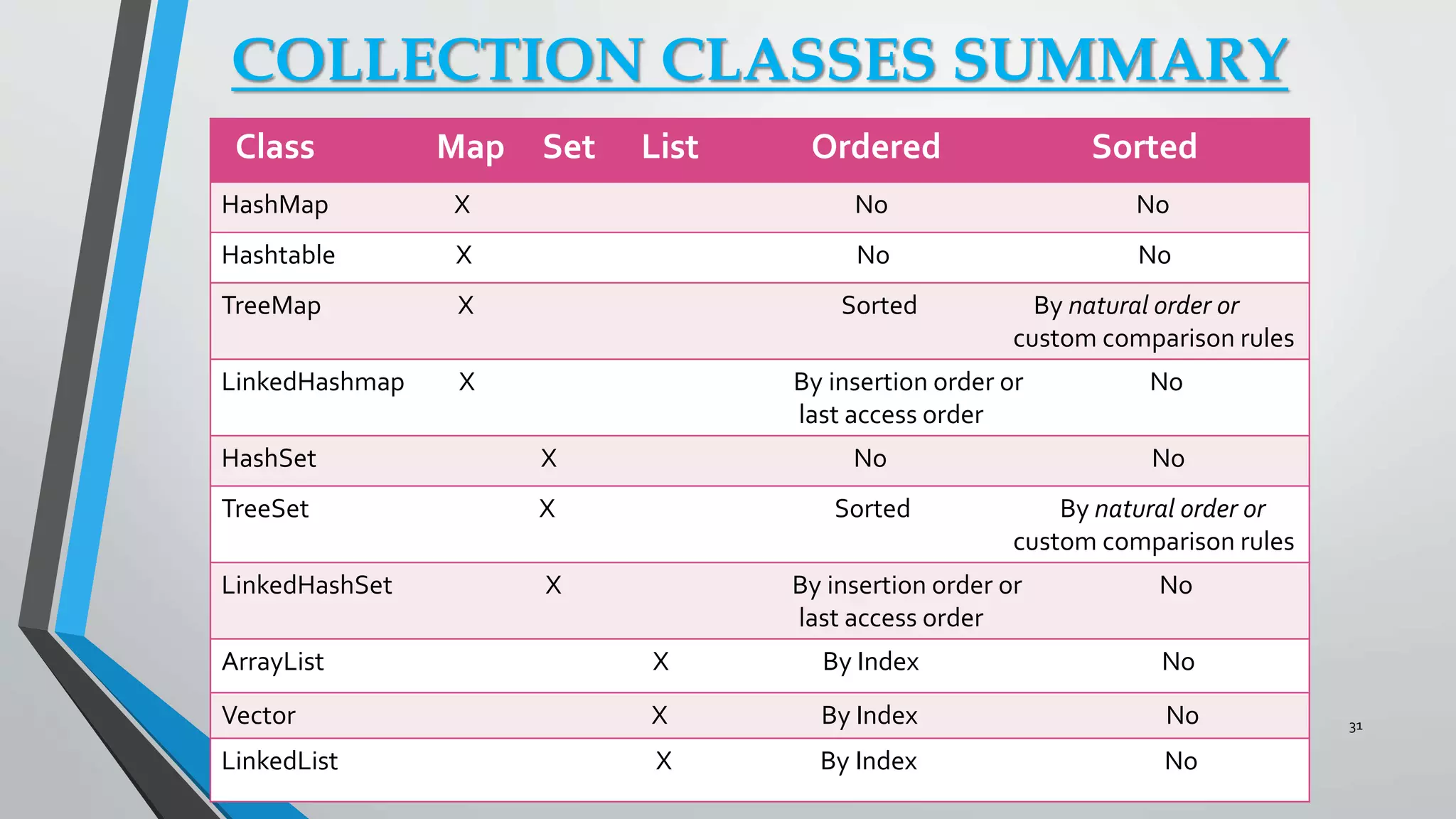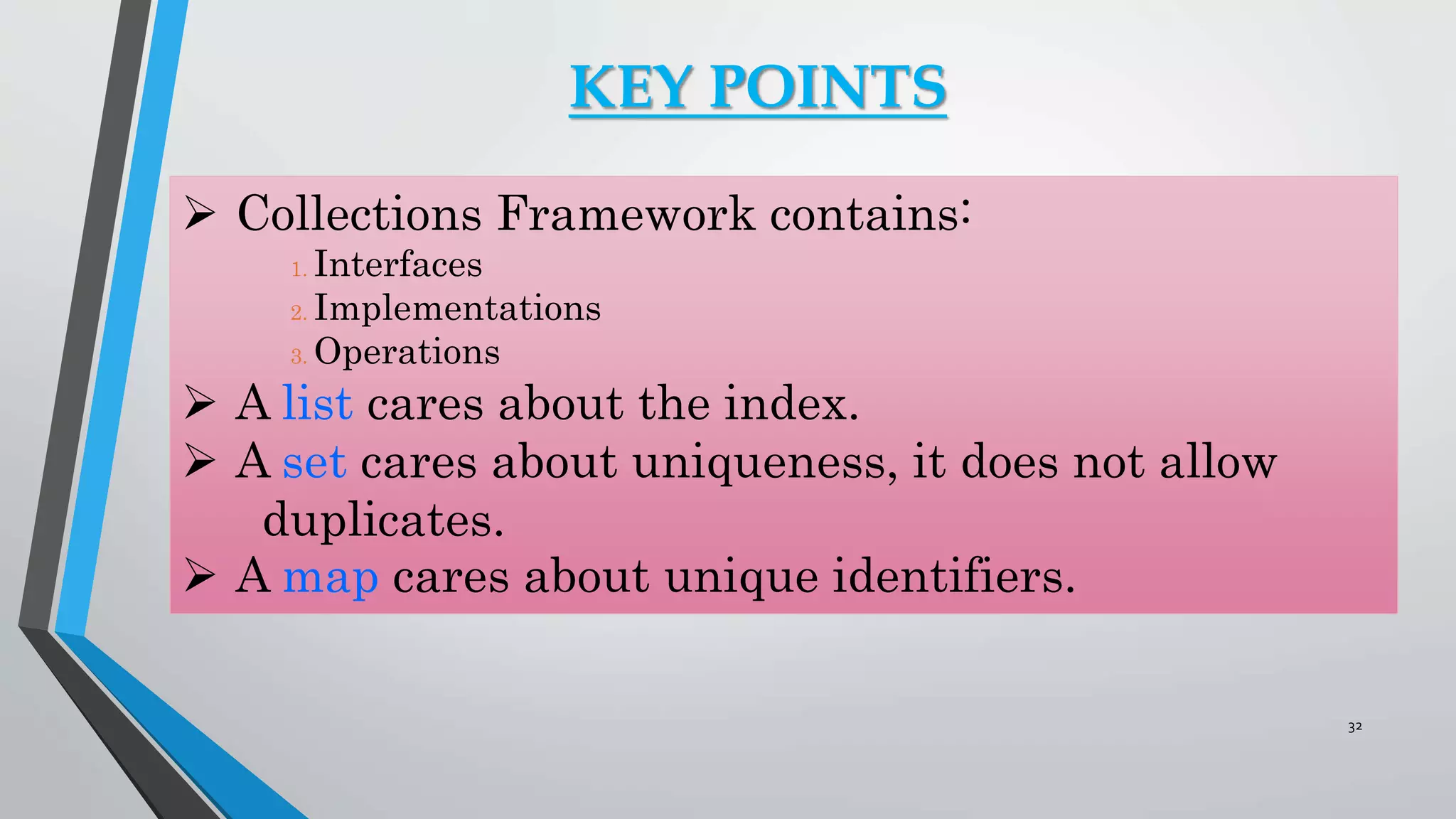This document provides an overview of Java's collections framework. It discusses the main interfaces like Collection, Set, List, and Map. It also describes some common implementations like ArrayList, LinkedList, HashSet, TreeMap. The key characteristics of lists, sets, and maps are explained. Lists maintain element order and allow duplicates. Sets do not allow duplicates. Maps contain unique keys that map to values. The document also covers common collection operations and using iterators to traverse elements.

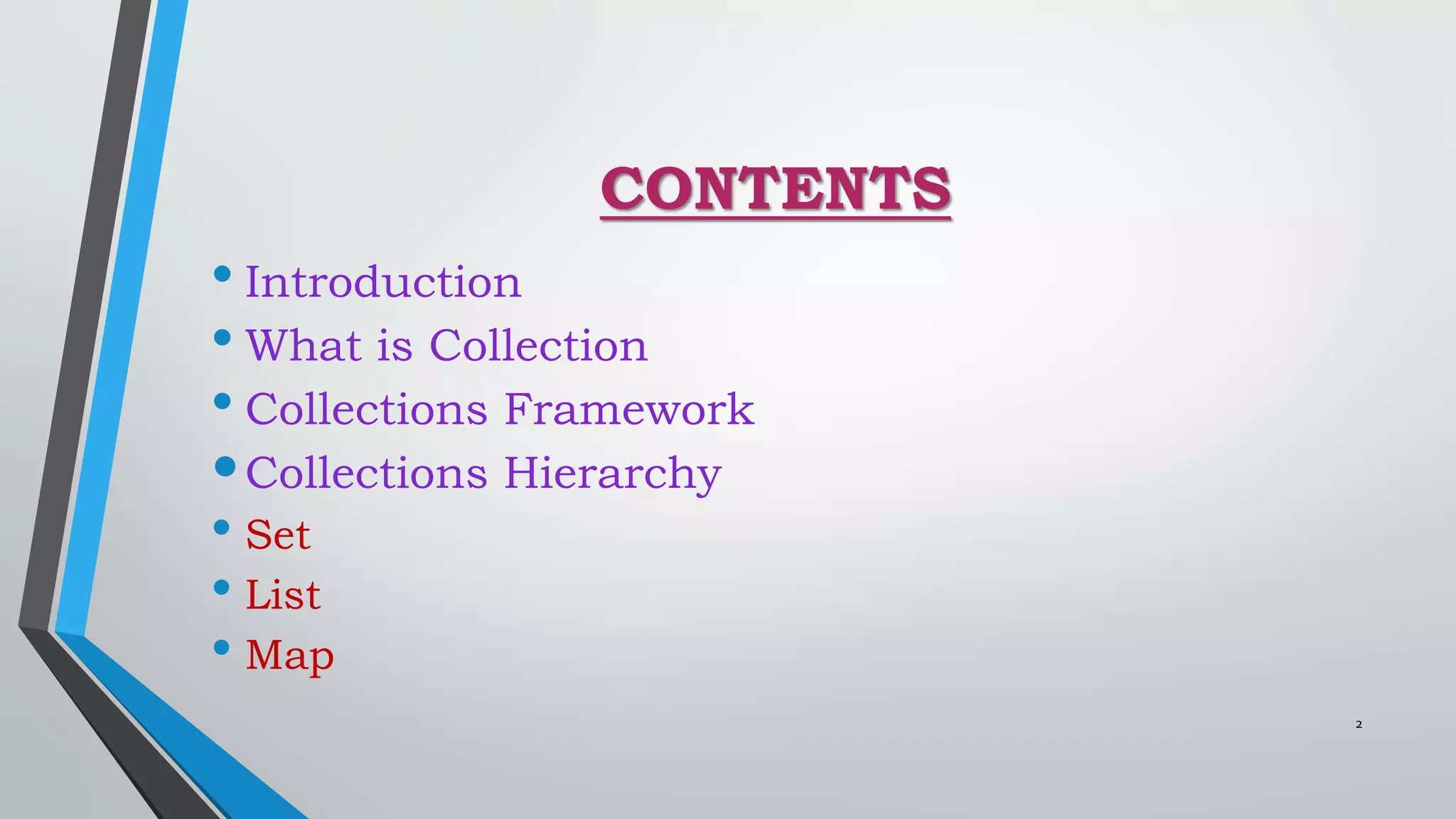
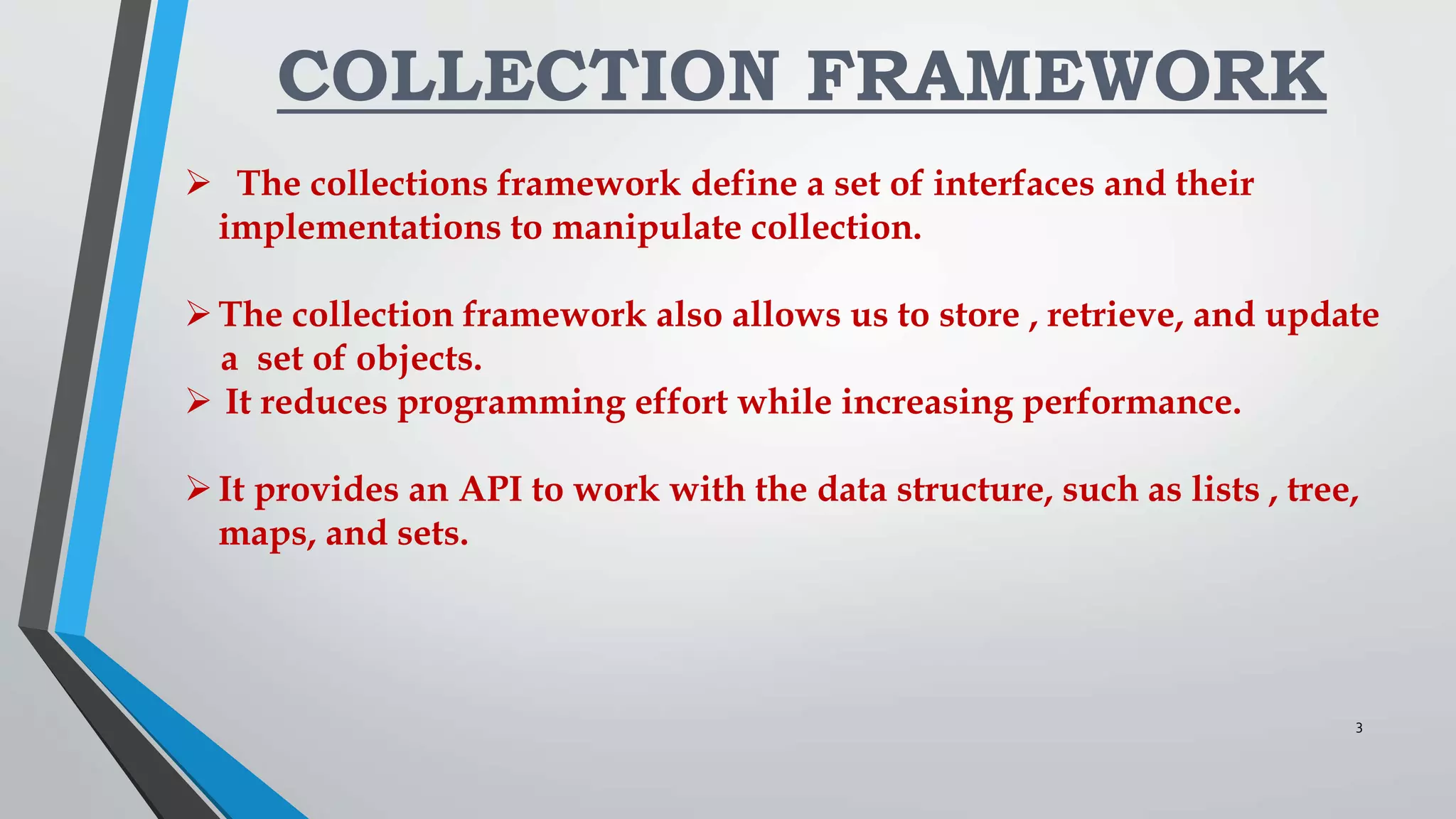
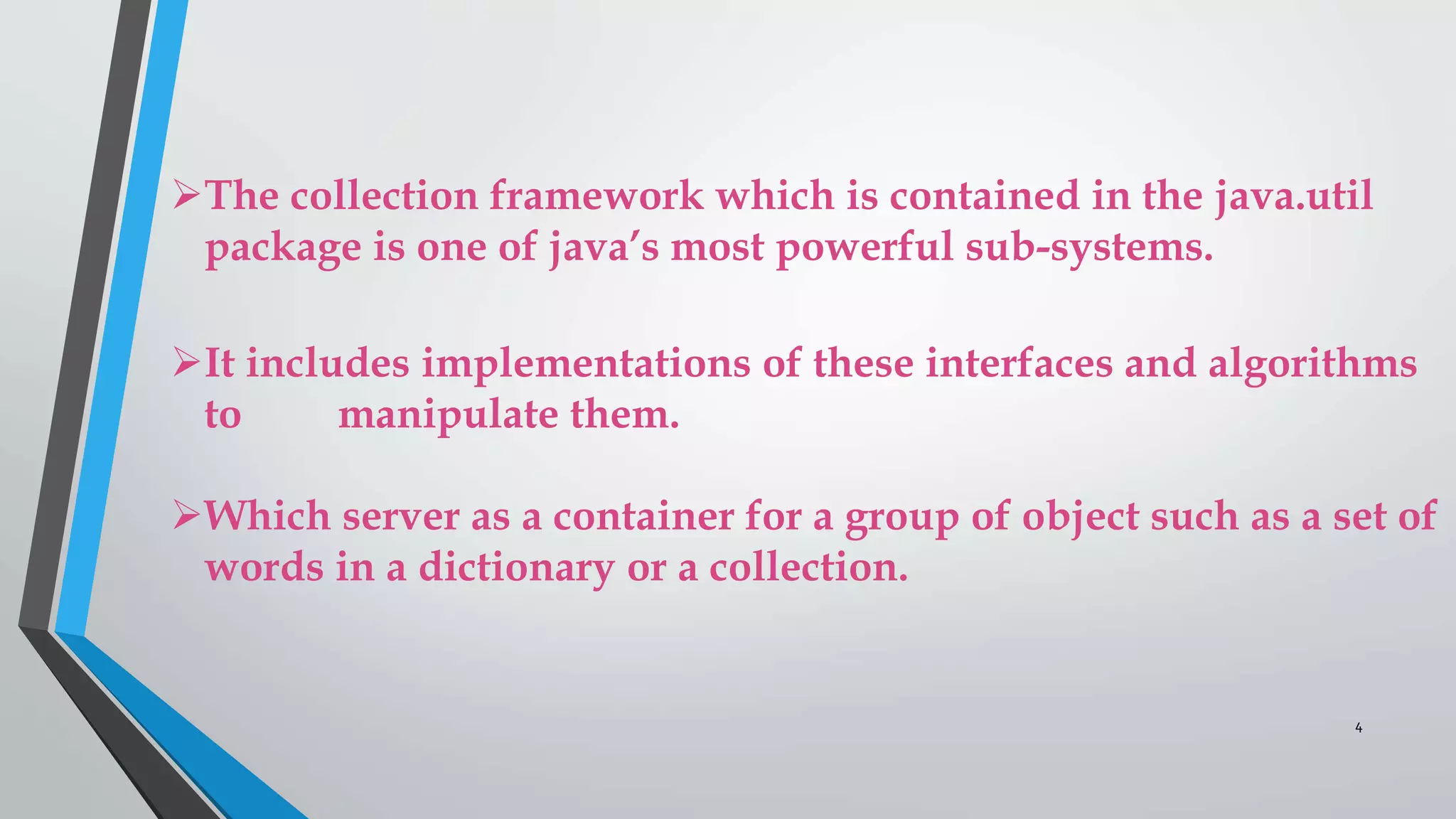
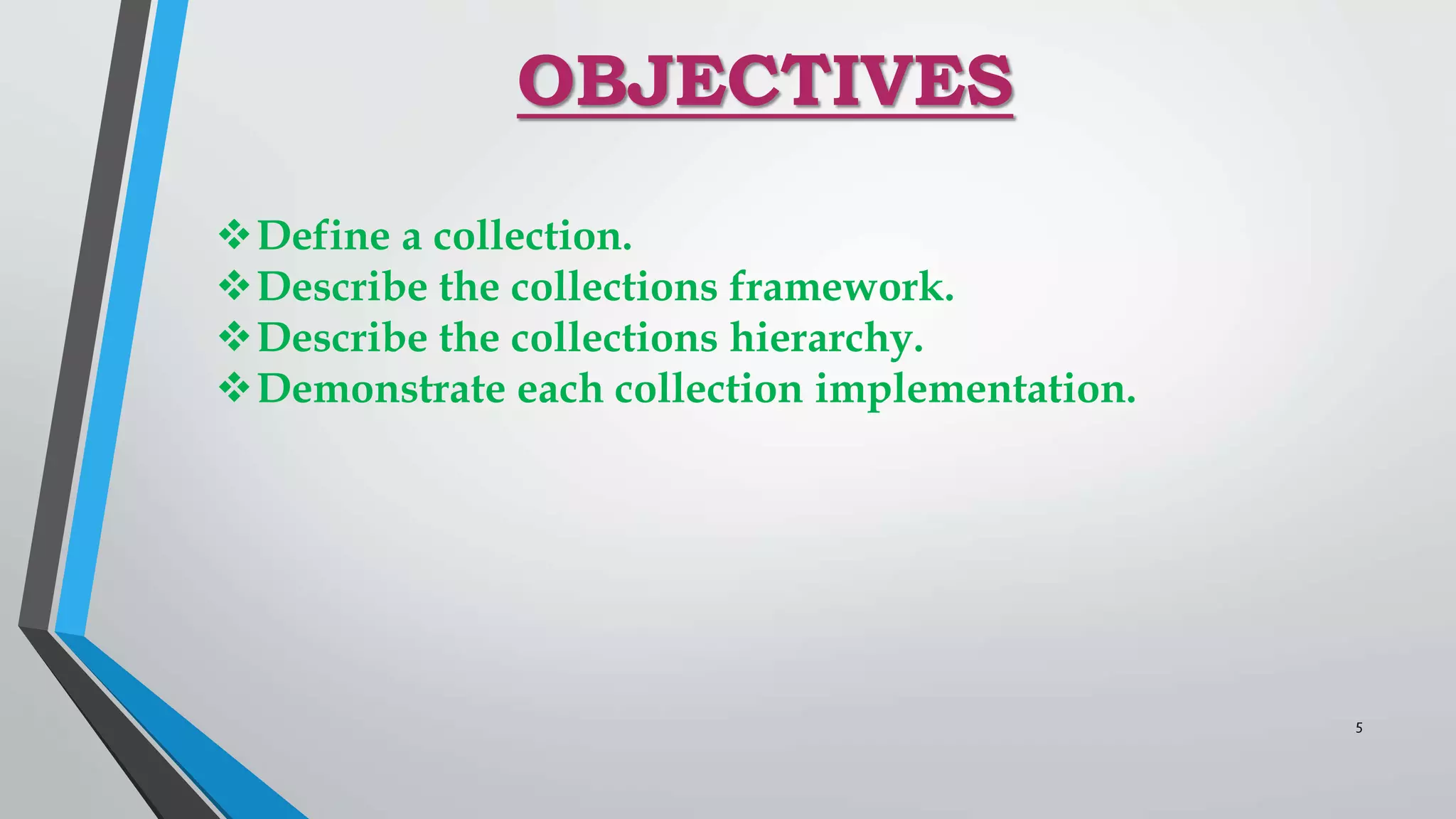
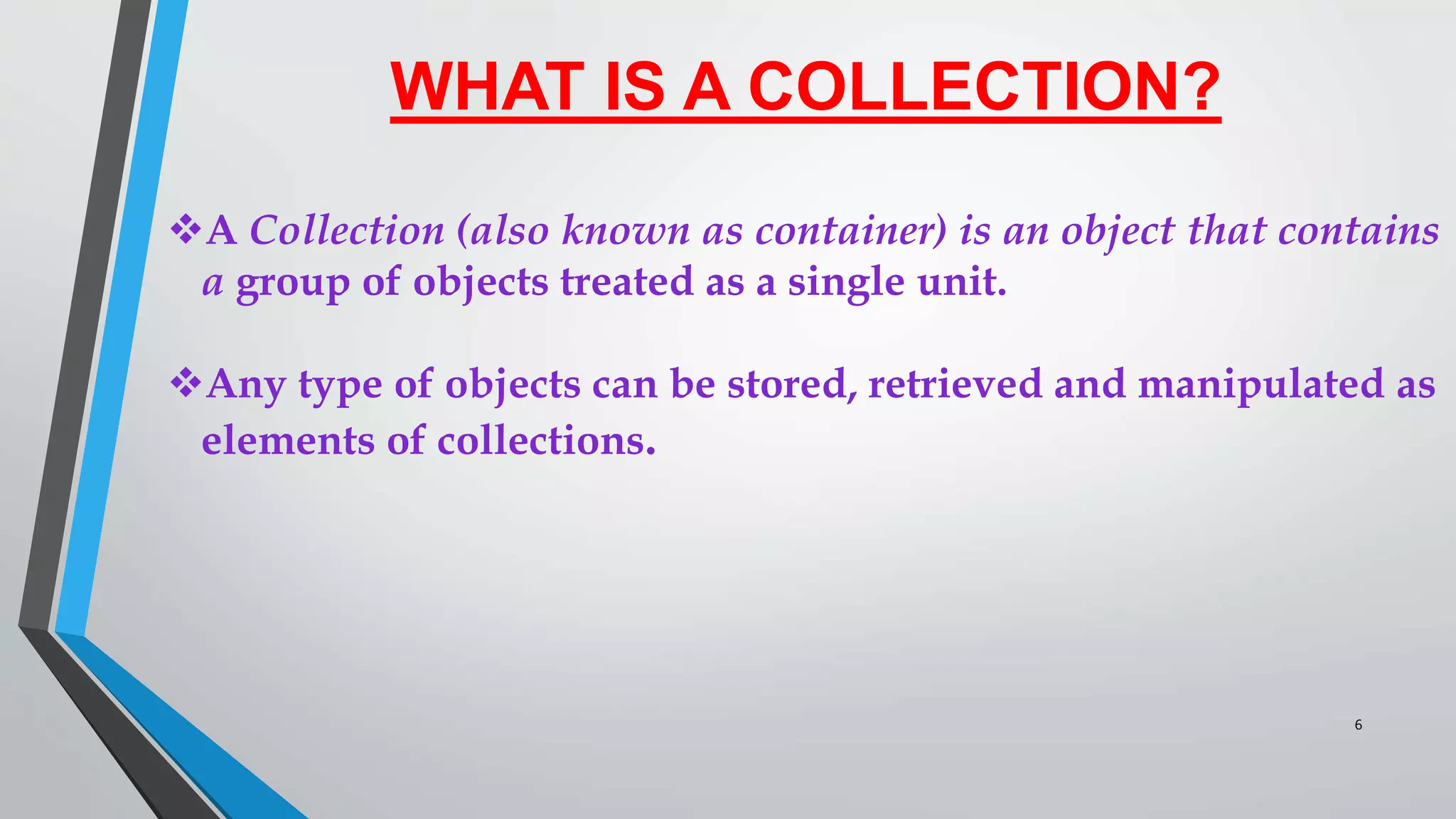
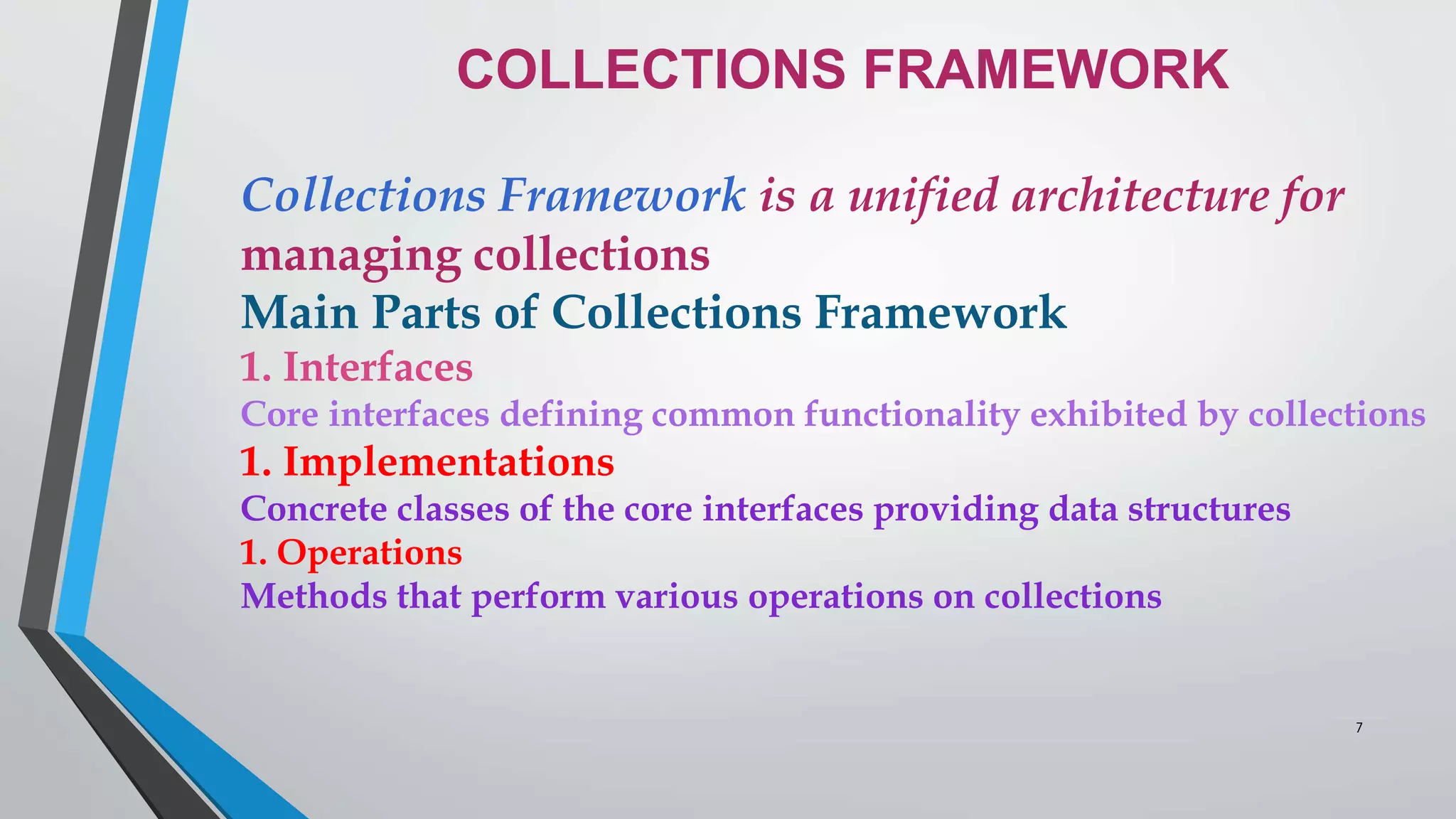
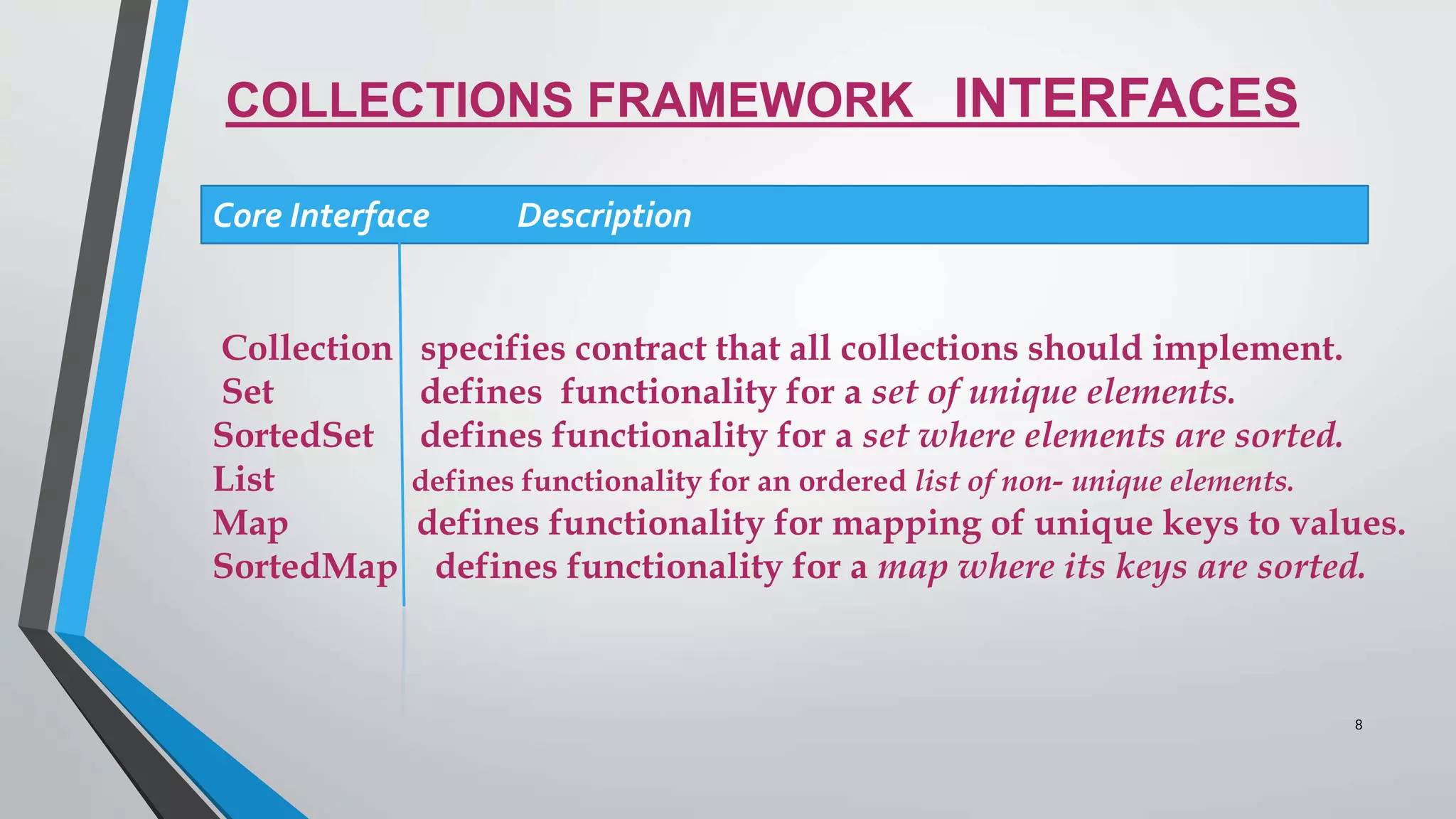
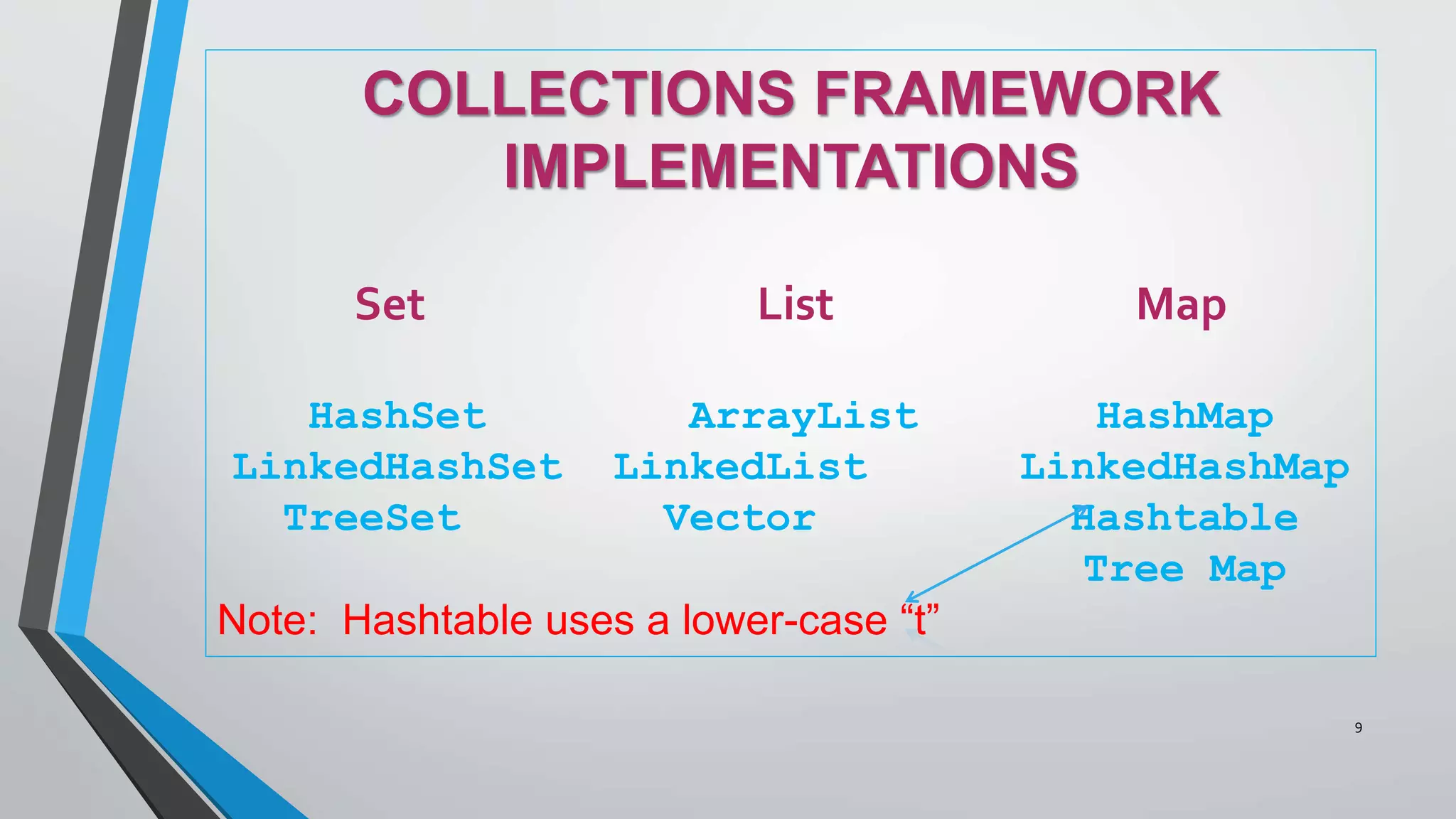
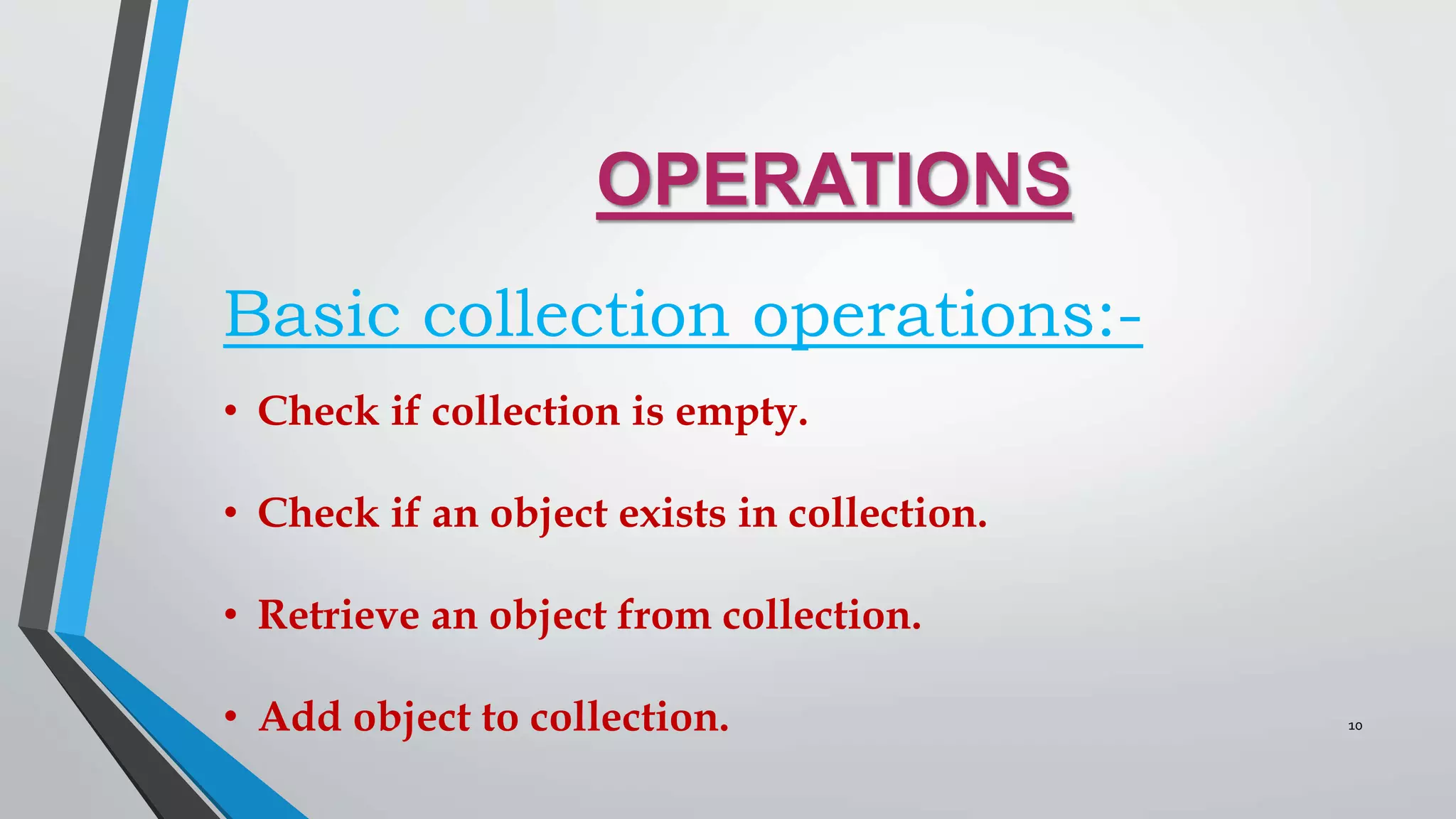
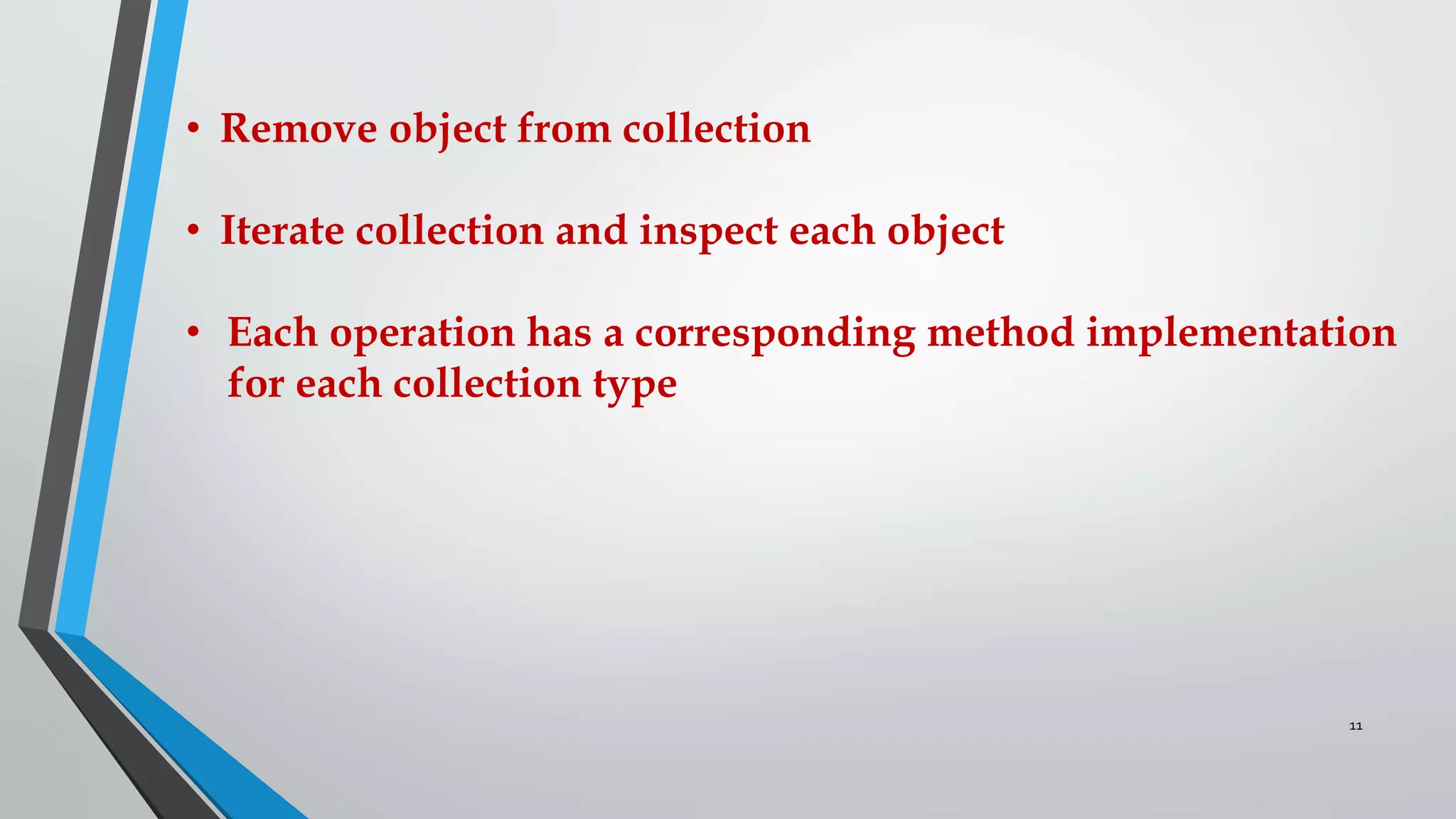
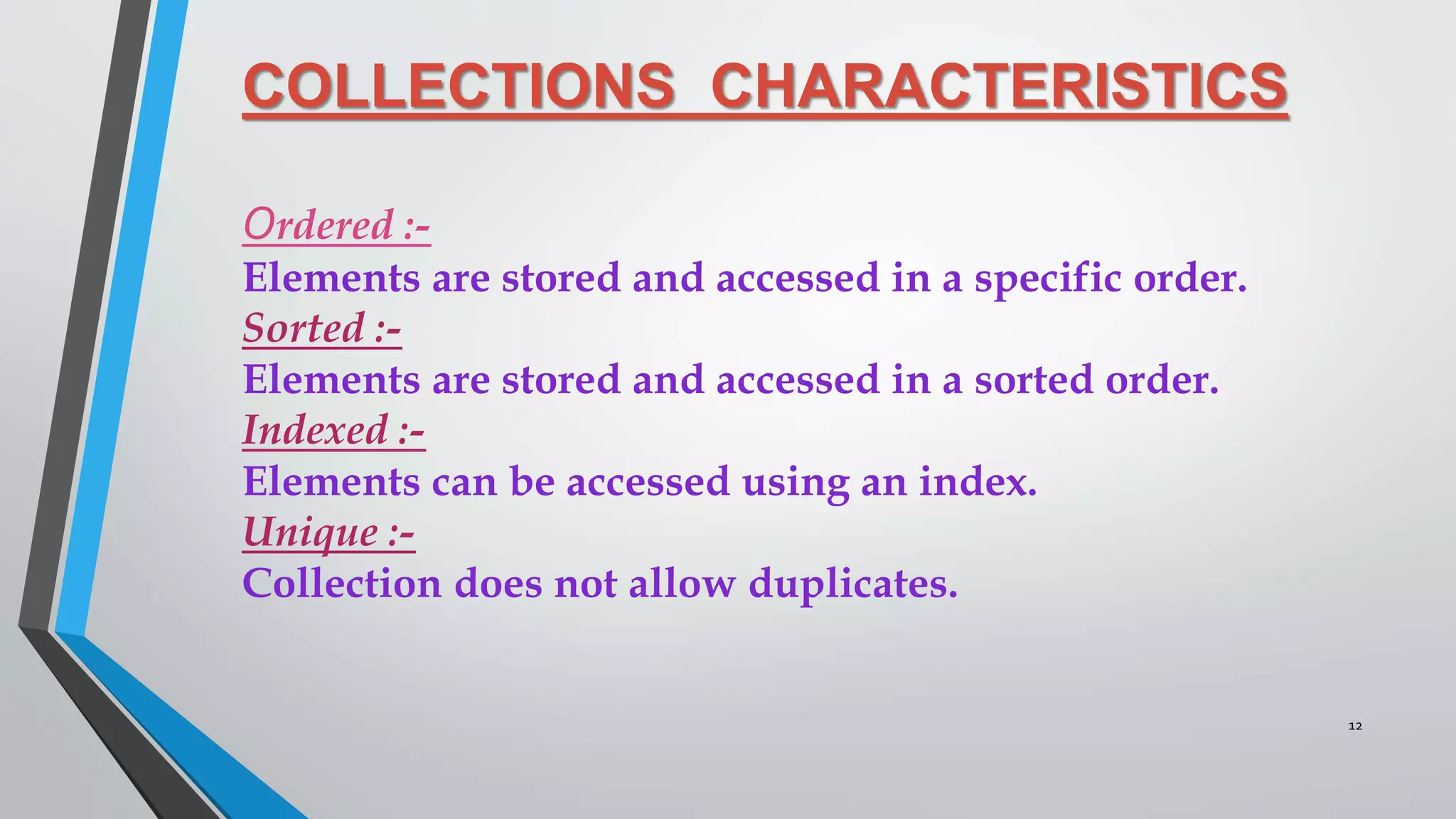
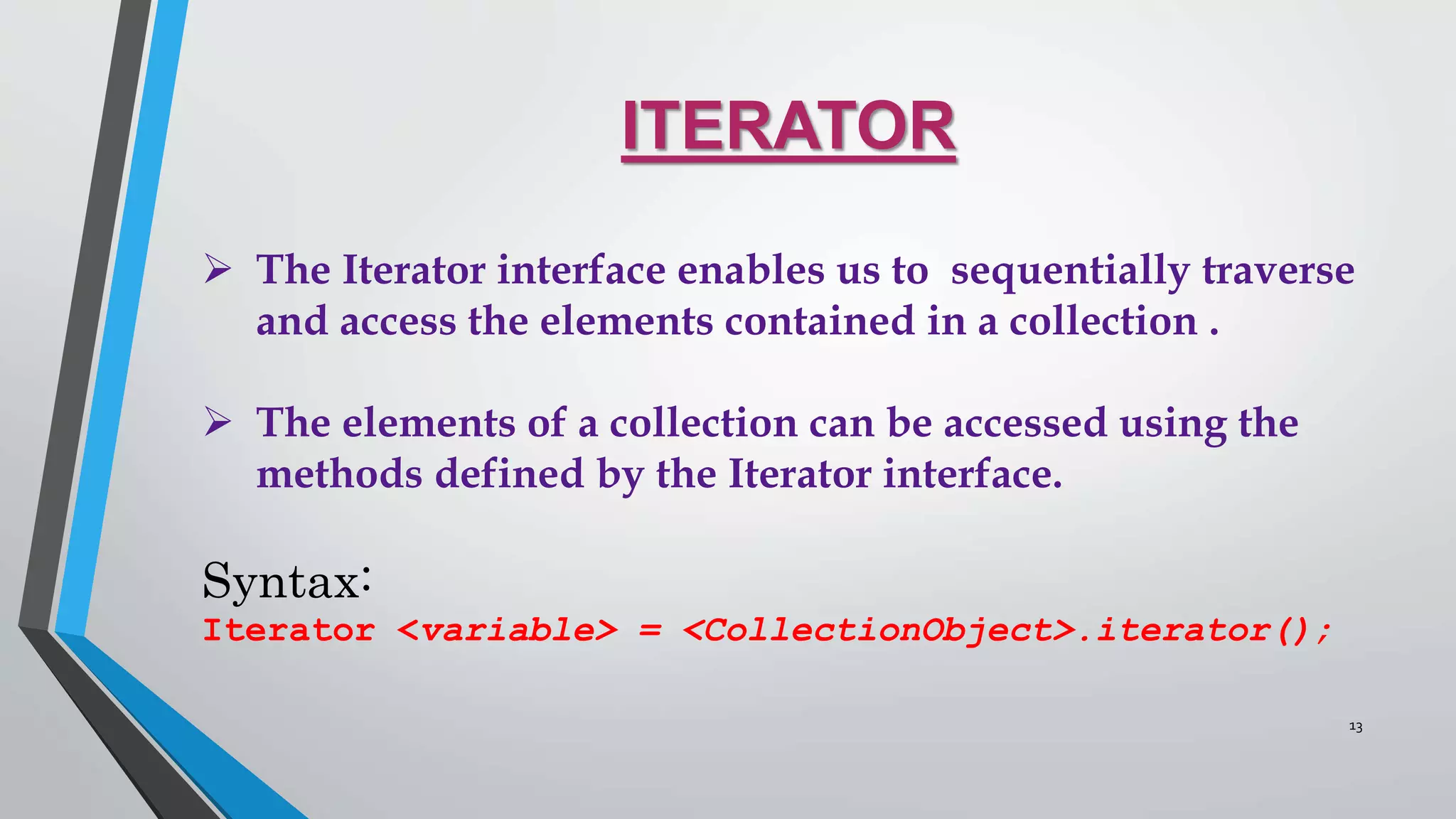
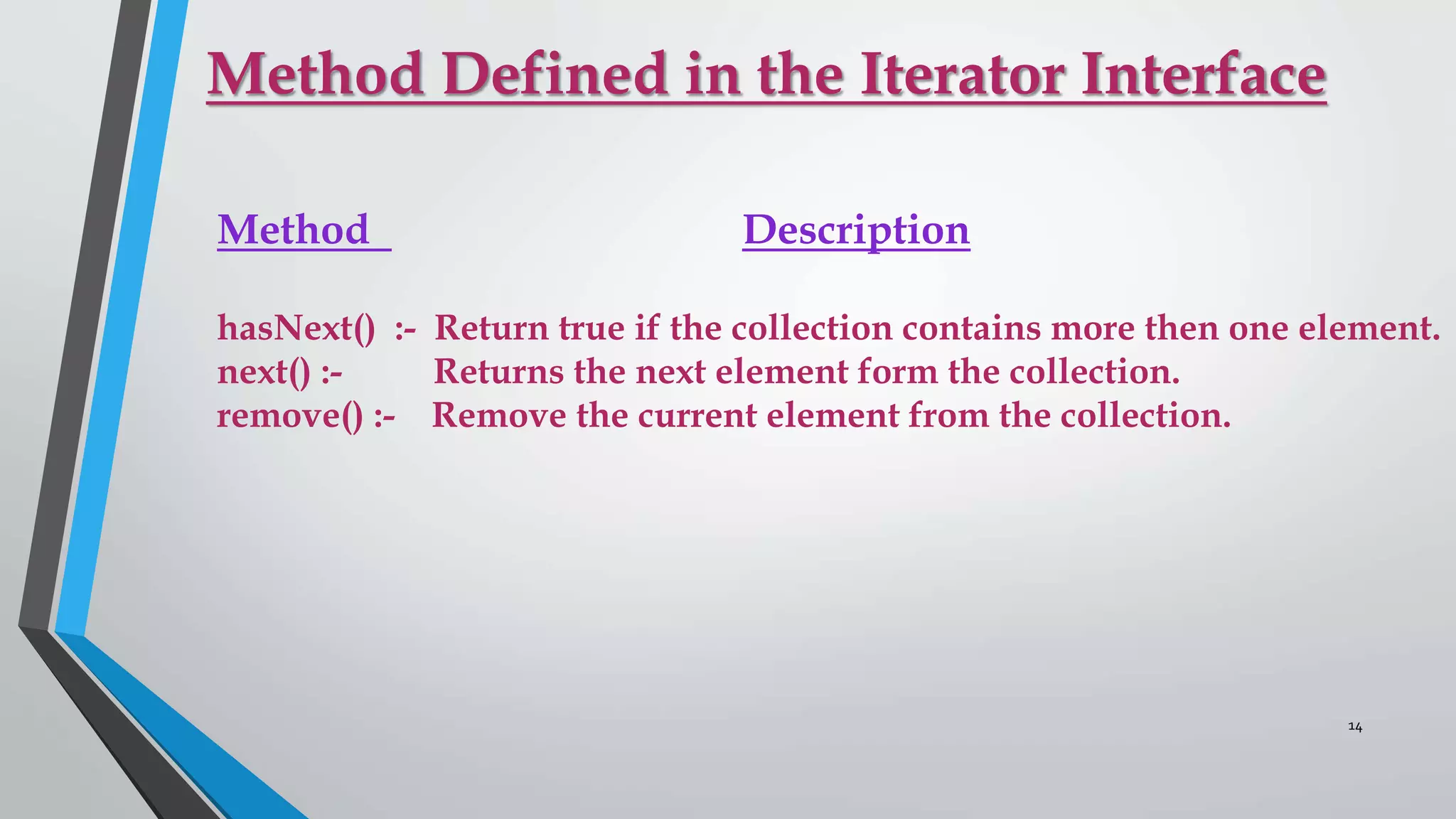
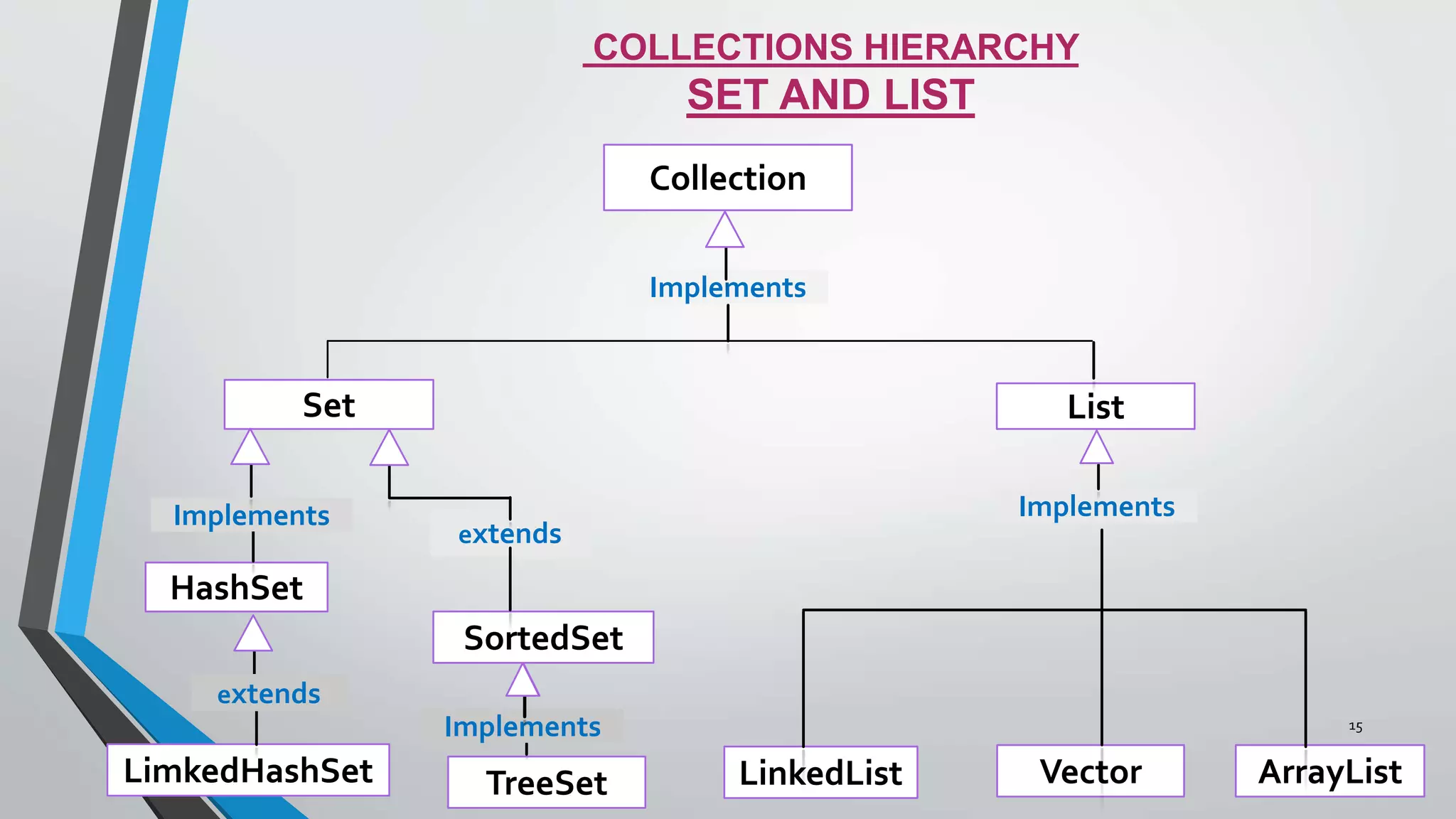
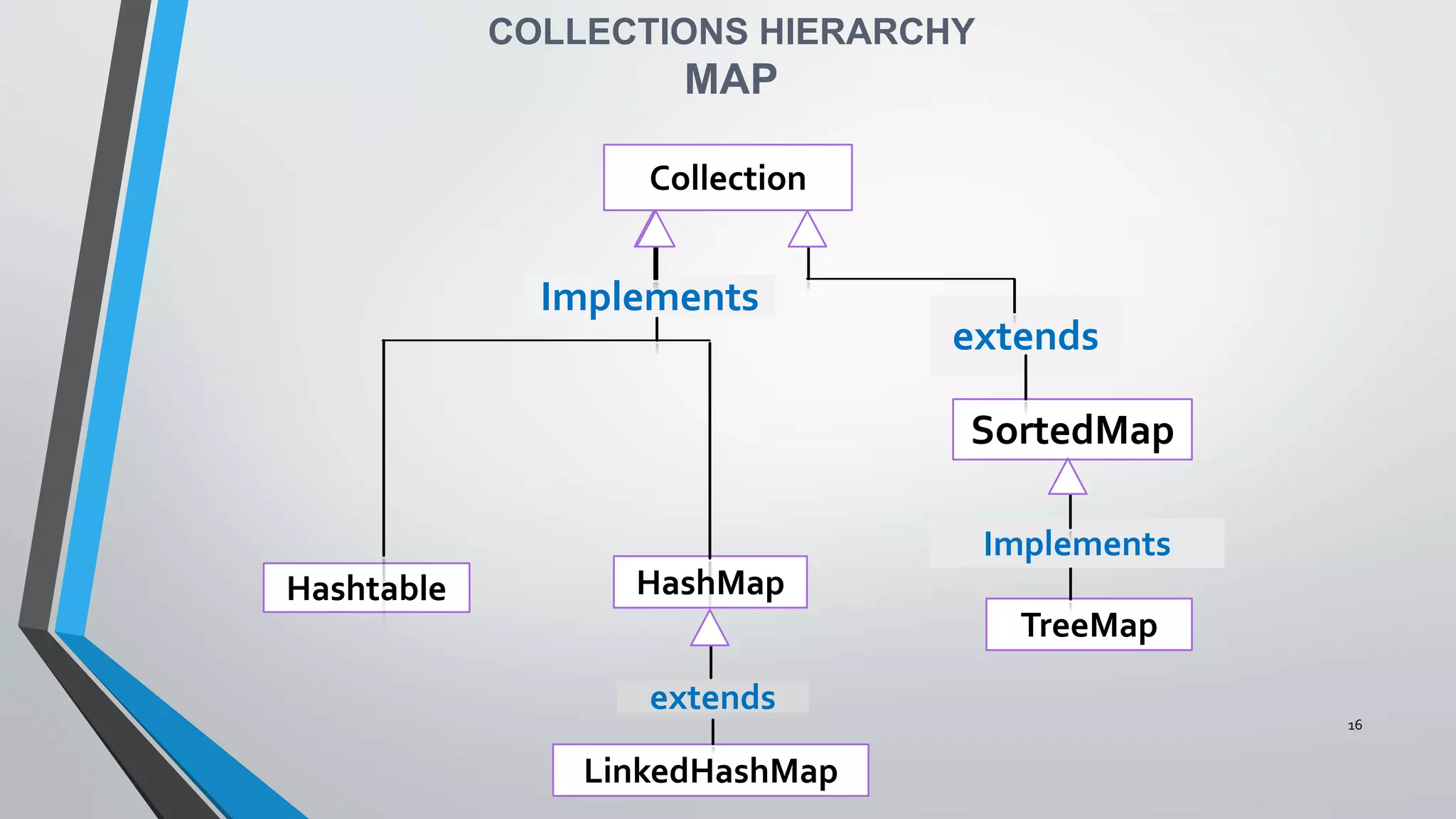
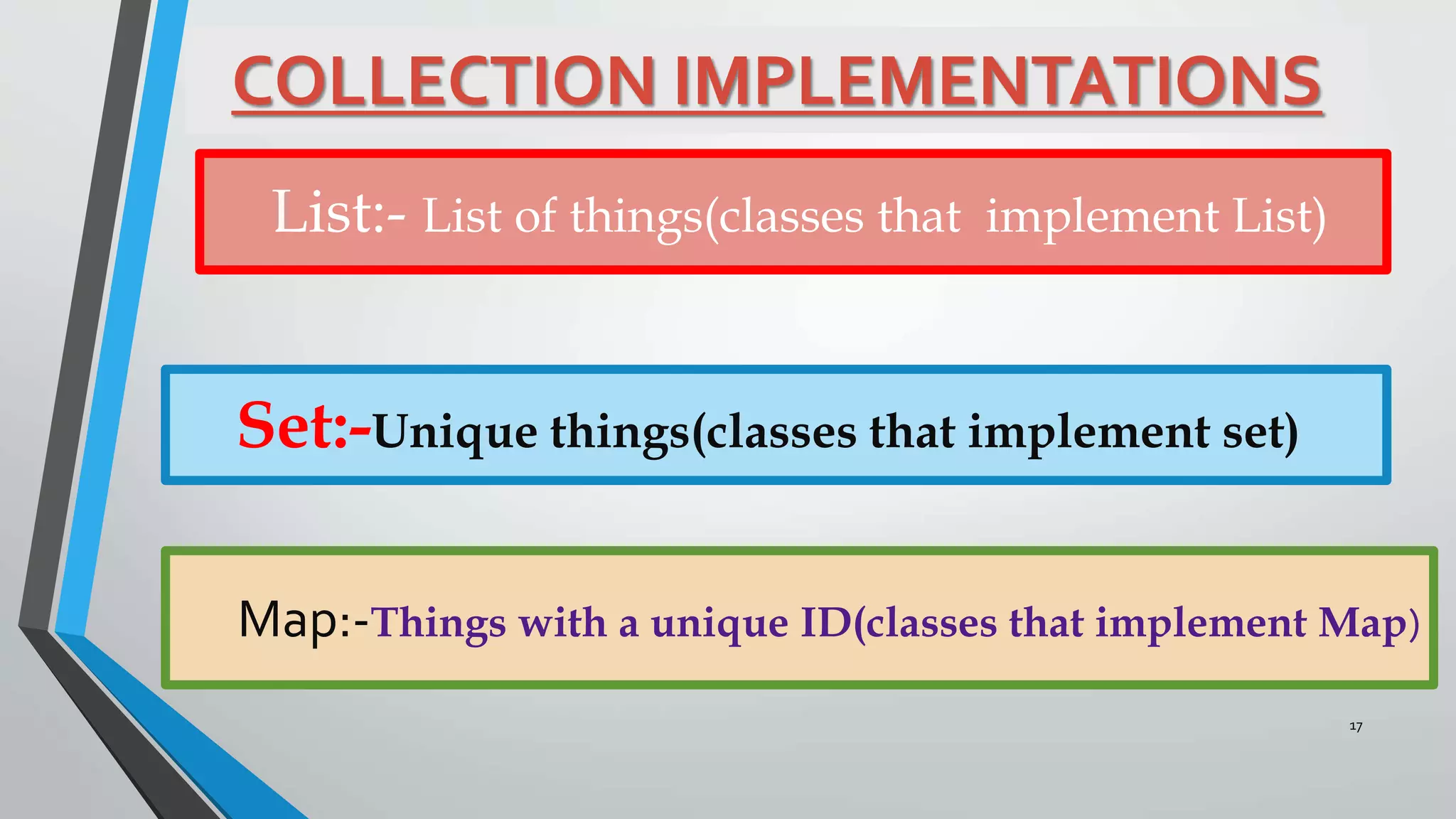
![LIST IMPLEMENTATIONS
ARRAY LIST
Import java.util.ArrayList;
public class MyArrayList {
public static void main(string args[ ]) {
ArrayList alist=new ArrayList( );
alist.add(new string(“one”) );
alist.add(new string(“two”) );
alist.add(new string(“three”) );
system.out.println(alist.get(0) );
system.out.println(alist.get(1) );
system.out.println(alist.get(2) );
}
}
One
Two
Three
19](https://image.slidesharecdn.com/javaprograming-171012084019/75/collection-framework-in-java-18-2048.jpg)
![LIST IMPLEMENTATIONS
VECTOR
Import java.util.Vector;
public class MyVector {
public static void main(string args[ ]) {
Vector vecky=newVector( );
vecky.add(new Integer(1) );
vecky.add(new Integer(2) );
vecky.add(new Integer(3) );
for(int x=0 ; x<3 ; x++) {
system.out.println(vecky.get(x) );
}
}
}
1
2
3
20](https://image.slidesharecdn.com/javaprograming-171012084019/75/collection-framework-in-java-19-2048.jpg)
![LIST IMPLEMENTATIONS
LINKEDLIST
Import java.util.LinkedList;
public class MyLinkedList {
public static void main(string args[ ] ) {
LinkedList link=new LinkedList( );
link.add(new Double(2.0) );
link.addlast(new Double(3 .0) );
link.addfirst(new Double(1 .0) );
object array[ ] = link.toArray ( );
for( int x=0 ; x<3 ; x++) {
system.out.println( array[x] );
}
}
}
1.0
2.0
3 .0
21](https://image.slidesharecdn.com/javaprograming-171012084019/75/collection-framework-in-java-20-2048.jpg)
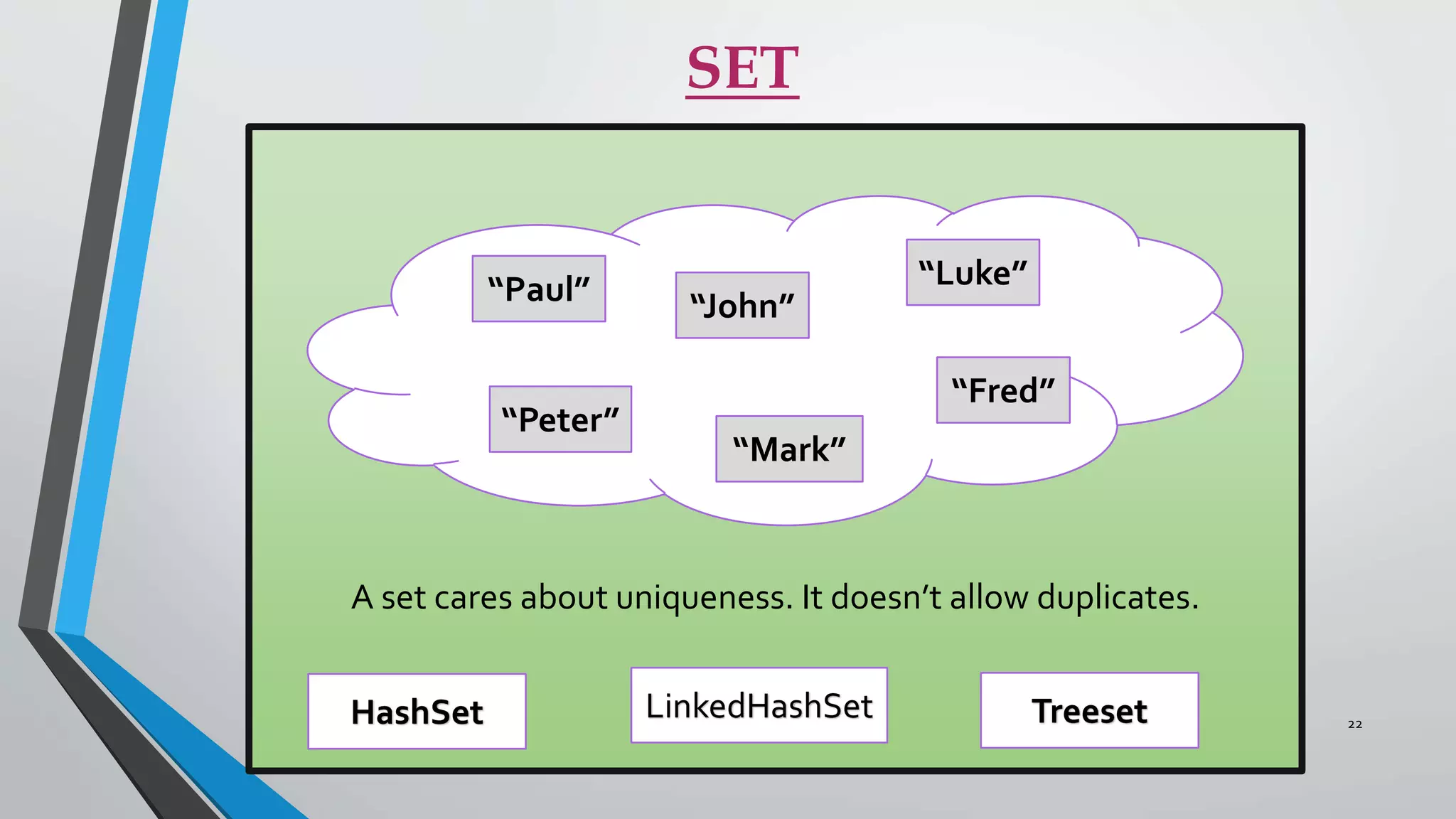
![LIST IMPLEMENTATIONS
HASHSET
Import java.util.*;
public class MyHashSet {
public static void main(string args[ ] ) {
HashSet hash=new HashSet( );
hash.add(“a” );
hash.add(“b” );
hash.add(“c”);
hash.add(“d”);
iterator iterator = hash.iterator( );
while(iterator.hashnext( ) ) {
system.out.println( iterator.next( ) );
}
}
}
d
a
c
b
23](https://image.slidesharecdn.com/javaprograming-171012084019/75/collection-framework-in-java-22-2048.jpg)
![LIST IMPLEMENTATIONS
LINKEDHASHSET
Import java.util.LinkedhashSet;
public class MyLinkedHashSet {
public static void main(string args[ ] ) {
LinkedHashSet lhs=new LinkedHashSet( );
lhs.add(new string(“one” ) );
lhs.add(new string(“two” ) );
lhs.add(new string(“three”) );
object array = lhs.toArray[ ];
for(int x=0; x<3; x++) {
system.out.println( array[x] );
}
}
}
One
Two
Three
24](https://image.slidesharecdn.com/javaprograming-171012084019/75/collection-framework-in-java-23-2048.jpg)
![import java.util.TreeSet;
public class MyTreeSet {
public static void main(String args[ ]) {
TreeSet tree = new TreeSet();
tree.add("Jody");
tree.add("Remiel");
tree.add("Reggie");
tree.add("Philippe");
Iterator iterator = tree.iterator( );
while(iterator.hasNext( )) {
System.out.println(iterator.next( .toString( ));
}
}
}
SET IMPLEMENTATIONS
TREE SET
Jody
Philippe
Reggie
Remiel
25](https://image.slidesharecdn.com/javaprograming-171012084019/75/collection-framework-in-java-24-2048.jpg)
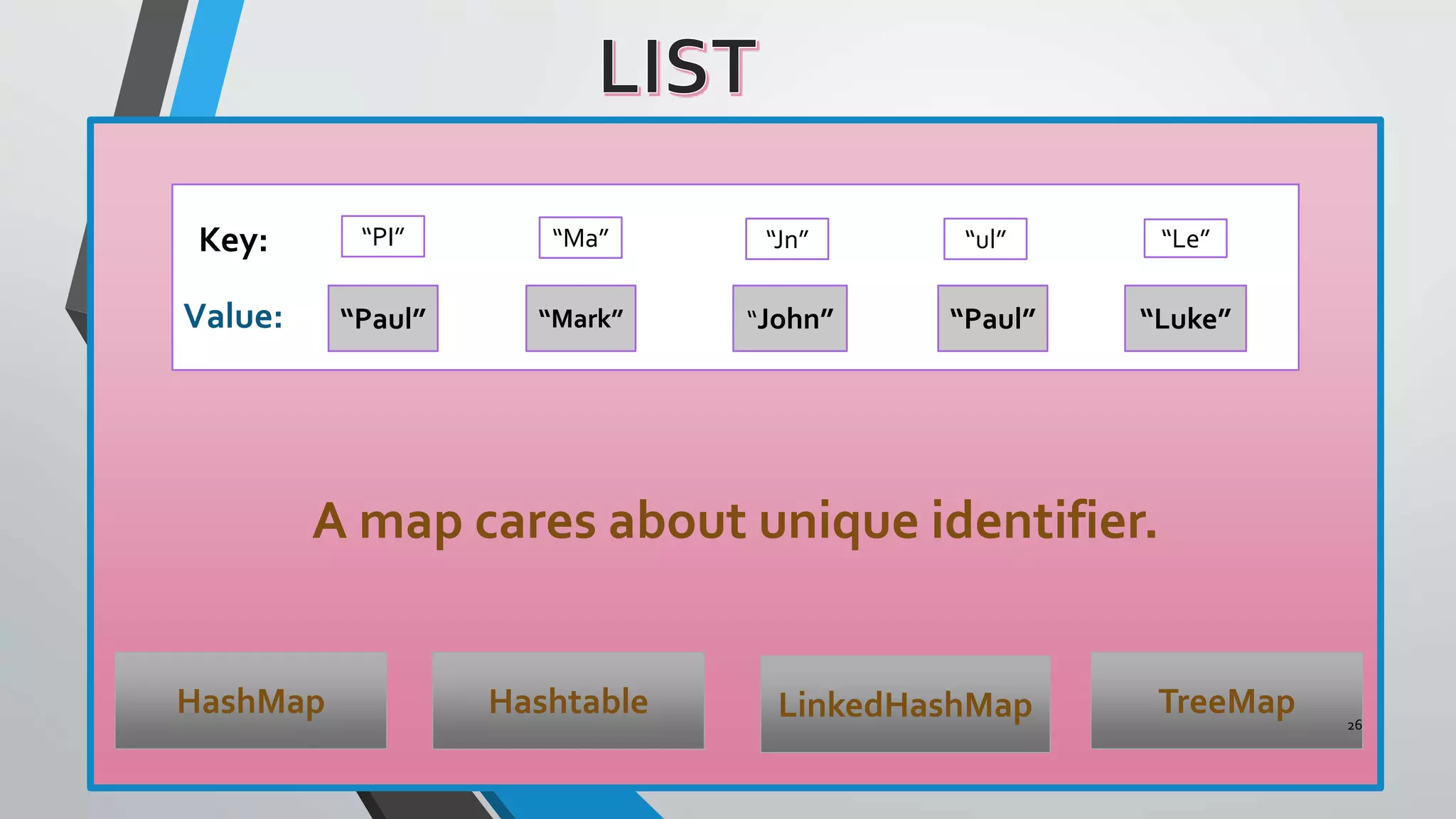
![MAP IMPLEMENTATIONS HASH MAP
import java.util.HashMap;
public class MyHashMap {
public static void main(String args[
]) {
HashMap map = new HashMap( );
map.put("name", "Jody");
map.put("id", new Integer(446));
map.put("address", "Manila");
System.out.println("Name:"+
map.get("name"));
System.out.println("ID: " +
map.get("id"));
System.out.println("Address: " +
map.get("address"));
}
}
Name: Jody
ID: 446
Address: Manila
27](https://image.slidesharecdn.com/javaprograming-171012084019/75/collection-framework-in-java-26-2048.jpg)
![MAP IMPLEMENTATIONS
HASH TABLE
import java.util.Hashtable;
public class MyHashtable {
public static void main(String args[ ]) {
Hashtable table = new Hashtable( );
table.put("name", "Jody");
table.put("id", new Integer(1001));
table.put("address", new String("Manila"));
System.out.println("Table of Contents:" +
table);
}
} Table of Contents:
{address=Manila, name=Jody, id=1001}28](https://image.slidesharecdn.com/javaprograming-171012084019/75/collection-framework-in-java-27-2048.jpg)
![MAP IMPLEMENTATIONS
LINKED HASH MAP
import java.util.*;
public class MyLinkedHashMap {
public static void main(String args[ ])
{
int iNum = 0;
LinkedHashMap myMap = new
LinkedHashMap( );
myMap.put("name", "Jody");
myMap.put("id", new Integer(446));
myMap.put("address", "Manila");
myMap.put("type", "Savings");
Collection values = myMap.values( );
Iterator iterator = values.iterator( );
while(iterator.hasNext()) {
System.out.println(iterator.next( ));
}
}
}
Jody
446
Manila
Savings
29](https://image.slidesharecdn.com/javaprograming-171012084019/75/collection-framework-in-java-28-2048.jpg)
![MAP IMPLEMENTATIONS
TREE MAP
import java.util.*;
public class MyTreeMap {
public static void main(String args[]) {
TreeMap treeMap = new TreeMap( );
treeMap.put("name", "Jody");
treeMap.put("id", new Integer(446));
treeMap.put("address", "Manila");
Collection values = treeMap.values()
Iterator iterator = values.iterator( );
System.out.println("Printing the
VALUES....");
while (iterator.hasNext()) {
System.out.println(iterator.next( ));
}
}
}
Printing theVALUES....
Manila
446
Jody
30](https://image.slidesharecdn.com/javaprograming-171012084019/75/collection-framework-in-java-29-2048.jpg)
